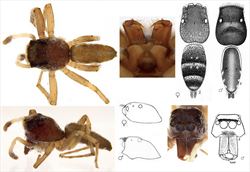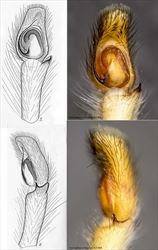
Examples of live Cosmophasis
Illustrator (and ©) A.R. Macaulay (TM, BL), R. Whyte

Aspects of the general morphology of Cosmophasis
Illustrators (and ©) B.J. Richardson (CSIRO), M. Zabka (diag.) (QMB)

Palp morphology of Cosmophasis
Illustrators (and ©) R. Whyte, M. Zabka (diag.) (QMB)

Epigyne morphology of Cosmophasis
Illustrators (and ©) R. Whyte, M. Zabka (diag.) (QMB)
Cosmophasis Simon, 1901
Taxonomy
Cosmophasis, found in Australian, Pacific and Oriental Regions has ten Australian species: Cosmophasis baehrae, C. bitaeniata, C. colemani, C. darwini, C. lami, C. modesta (doubtful), C. micans (C. thalassina misidentified by Koch), C. micarioides, C. obscura (doubtful) and C. thalassina. Many of these are shared with Papua New Guinea, Indonesia, Singapore and Malaysia. Cosmophasis lami from Fiji is found in Australia in ports (Darwin, Townsville and on the Cocos-Keeling Islands, Whyte and Anderson, 2017, Richardson unpubl.) suggesting human-aided dispersal. Specimens identified as Cosmophasis micans are usually Cosmophasis thalassina, the most common Australian species. Further information on the genus and described species can be found in Żabka and Waldock (2012), Richardson and Żabka (2017) and Whyte and Anderson (2017).
Description
Cosmophasis spp. are medium-sized to large spiders, with body lengths ranging from 5 to 11 mm, usually with a long, narrow abdomen and a high, flat-faced cephalothorax and long jaws. Others can be rounded with the abdomen as wide as, or wider than the cephalothorax and with shorter jaws. Many species are very brightly-coloured, especially as juveniles, with latitudinal and longitudinal metallic green, orange, red, yellow, black, brown and white stripes while others are more subdued in colour. The chelicerae have a single retro-marginal tooth (unident) with two teeth on the promargin. Some species also have a large projecting tooth on the front of the paturon. The legs are slender and do not differ greatly in length.
The male’s palp has a long, slender embolus arising from the proximal or lateral edge of the tegulum which extends distally well past the tegulum. The tegulum is rounded and without a proximal lobe. The retro-lateral tibial apophysis is short and slender, sometimes with a hooked end.
The female has two epigynal atria adjacent to the epigastric fold with well-developed guides. The copulatory openings are located near the posterior edge of the atria and lead to insemination ducts which travel anteriorly, following a convoluted path then joining highly-convoluted, tube-like spermathecae.
Biology
Cosmophasis spp. are found on foliage in habitats ranging from grasslands to rainforest. Cosmophasis bitaeniata cohabits with ants and is a chemical (rather than physical) ant-mimic (Allen et al. 2001, 2002). Cosmophasis has been used in studies of spider vision, for example by Li and co-workers (2005). Males, especially Cosmophasis thalassina, drum the substrate with their pedipalps.
Distribution
Cosmophasis is found in the northern half of Australia south to Brisbane, and on offshore islands, as well as southeast Asia and the southwest Pacific. Cosmophasis baehrae is the most widespread species and is found from coastal WA to Brisbane Qld and well inland in the tropics.
References
Allan, R.A., Capon, R.J., Brown, W.V. & Elgar, M.A. 2002. Mimicry of host cuticular hydrocarbons by salticid spider Cosmophasis bitaeniata that prey on larvae of tree ants Oecophylla smaragdina. Journal of Chemical Ecology 28, 835-848.
Allen, R.A. & Elgar, M.A. 2001. Exploitation of the green tree ant Oecophylla smaragdina, by the salticid spider Cosmophasis bitaeniata. Australian Journal of Zoology 49, 129-137.
Davies, V.T. & Żabka, M. 1989. Illustrated keys to the genera of jumping spiders (Araneae: Salticidae) in Australia. Memoirs of the Queensland Museum 27, 189-266.
Elgar, M.A. & Allan, R.A. 2006. Chemical mimicry of the ant Oecophylla smaragdina by the myrmecophilous spider Cosmophasis bitaeniata. Journal of Ethology 24, 239-246.
Li, D. & Lim, M.L.M. 2005. Ultraviolet cues affect the foraging behaviour of jumping spiders. Animal Behaviour 70, 771-776.
Richardson, B.J. & Żabka, M. 2016. Salticidae. Arachnida: Araneomorphae. Canberra, Australian Faunal Directory. Australian Biological Resources Study, at https://biodiversity.org.au/afd/taxa/SALTICIDAE.
Whyte, R. & Anderson, G. 2017. A Field Guide to Spiders of Australia. CSIRO Publishing: Clayton.
Żabka, M. & Waldock, J. 2012. Salticidae (Arachnida: Araneae) from Oriental, Australian and Pacific regions. Genus Cosmophasis Simon, 1901. Annales Zoologici, Warszawa 62, 115-198.
* The information sheet should be read in the context of the associated diagrams and photographs. Diagrams explaining anatomical terms can be found in the ‘Salticidae’ pictures at the beginning of the list of genera.